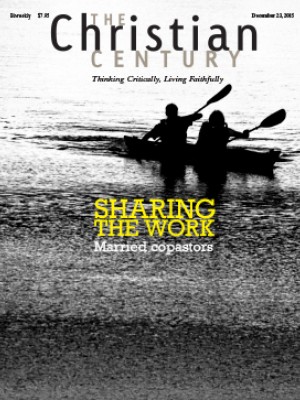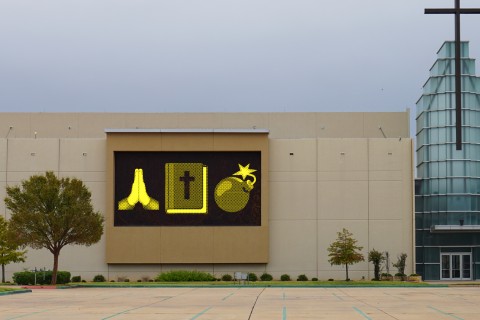Copastors: Twenty years in marriage and ministry

"Husband, wife join forces on the pulpit,” reads the laminated copy of a newspaper article that a church member found and gave to us when she was packing for a move. We were touched that she’d held on to the article for 20 years. A new clergy couple was a novelty in this traditional Pennsylvania Dutch area—a story that could fill pages in the local paper. After recently celebrating both our 20th anniversary at the church and our 35th wedding anniversary, we were inclined to reflect on our two-decade experiment of copastoring.
We never would have predicted that we’d still be here when we sat down with that newspaper reporter 20 years ago. We thought the vocational experiment might last seven years or so before we’d move on to other positions, either together or separately. After we found out that the church had a deficit that represented a third of its annual budget, we wondered how long the church could afford us, and what the minimum respectable time would be for us to stay before seeking a more financially stable congregation.
Read our latest issue or browse back issues.
Yet here we are. A faithful and energetic response by the congregation saw us through that initial financial crisis. Since then, factors common to most long-term pastorates have kept us here: a healthy congregation that knows how to support and affirm its leaders, enough growth and change to keep us feeling challenged and energized, a new associate pastor position that eases the ministry burden, and a congregation that has done a wonderful job of helping us raise our three daughters in the faith.
What has made this copastoring experiment work, both for the congregation and for us? What have been the pluses and minuses of being yoked in ministry and in marriage?
This was not our first position serving together. Kerry had served as a full-time associate pastor in another congregation while Carter attended seminary. At the end of the seminary experience, members of the congregation’s session asked us to serve together as part-time associate pastors. The three years of seminary had been difficult as we took on new roles and balanced work, family, and school. The new positions would give us a chance to experiment with working together without relocating. We agreed. With grudging approval from the presbytery, the congregation made it happen.
We liked the partnership, so we began looking for a church where we could serve as copastors. We received good advice from our seminary field placement director. He told us that congregations would have a number of questions about what this new model of copastoring would look like: Who would be in charge? How would church members know who to go to when they had a problem? What if church members had a preference between us when it came to weddings or funerals? Would we expect the church to provide child care for our young daughters?
On the personal information form that search committees reviewed, we spelled out our vision of how we would do things. We were looking for a congregation that needed more than one full-time pastor but could not afford two, since we wanted to share work and parenting. We would alternate leadership positions every year, and when one was serving as moderator of the governing body of the congregation, the other would serve as head of staff. We would staff the committees individually, alternate preaching Sundays, take vacation together, and take study leave both together and separately. We have largely followed that model.
From the beginning we tried to pay attention to power dynamics. Because the church had had a series of part-time people on staff, there were two available offices: a large, spacious office for the pastor, with built-in bookshelves that we both coveted, and a smaller office for the part-time assistants. We decided to put both of our desks in the larger office and use the smaller office as a conference room where one of us could go if we needed to meet with someone or if we needed a quieter space to work. Making that decision about the offices, and splitting up the preaching and moderation of the session, have helped foster a sense in the congregation that we are true copastors, and that neither one of us is a junior partner to the other.
We also took into account gender and power dynamics in deciding how to relate to church committees. In general, we divided the committees according to our interests and gifts, but we were both drawn to the spiritual formation and mission committees; we decided that Carter would staff spiritual formation and Kerry would staff mission. We were concerned about congregational perceptions if Carter was the face of our outreach ministries and Kerry was working in an area where most of the volunteers were women. Looking back, it feels like a wise decision and is perhaps one reason that we’ve had success in recruiting both male and female teachers and youth advisers.
We also decided that we would not ask the congregation to take on any more child care for our children than they would do for a more traditional pastor’s family. While we readily used any child care offered to all church families, we assumed that it was our personal responsibility to hire the necessary child care for work, just as it was for other families in the congregation.
When our youngest daughter was in that in-between stage—too old to have a babysitter but too young to be home alone—she often would do her homework or watch a movie in our office, which was on the other side of the wall from the room where the session meets. When she told us, “You sure seem to laugh a lot over there,” we knew that she was developing a positive view of congregational life.
Overall we appreciate how well the congregation has embraced the copastor model. To be sure, there was a season of skepticism at the beginning. Since Kerry was the first installed female pastor, there were some, especially among the older generation, who introduced her as the “pastor’s wife” and seemed to count Carter’s visits as more valuable than hers. But they were the exception; there have also been those who took special delight in their congregation doing “this new thing.” Now, after 20 years, they take copastoring for granted.
But we do not take the blessings for granted. Consider preaching. We are not rigid about our preaching schedule. From time to time one of us will preach two times in a row, but the two-week cycle is a great gift. There is time to put aside one sermon and let another text simmer and steep. And when a pastoral crisis erupts in the crunch time of sermon preparation, we appreciate that one of us is free to respond.
It’s been a great blessing to share work and parenting. Neither one of us is the one “always at meetings,” or the one “always at home.” Both at church and home, sharing work and parenting has kept us in balance.
We have also benefited from dividing responsibilities according to our gifts and talents. A mentor once told us that the key to any job is “to do enough of the things you love to stay energized.” We have found it far easier to do that as a clergy couple than on our own. Carter has an abiding interest in evangelism and membership outreach, and Kerry has a gift for worship planning and leadership. In some areas we’ve shared passions—spiritual formation and mission—and we have found ways for one to play a part when the other is “the one in charge.”
Of course, there are some aspects of ministry that we would just soon as avoid altogether, so it’s a blessing when we can share those too. We’re not alone with the burdens and responsibilities of ministry; we can bounce ideas off of each other and think through difficult issues together, whether it’s a budget matter or a congregational conflict. When we are in a meeting together, it’s valuable to have one person focusing on moderating the discussion, while the other is paying attention to group dynamics. Family systems writer Edwin Friedman often spoke of the need for pastors to be a “nonanxious presence.” Our partnership makes this easier.
We think parishioners would echo the local farmer in the congregation who points to the biodiversity of a meadow as a metaphor for clergy copastoring: because different forms of life are allowed to flourish, the life of the whole grows richer and stronger. People talk about the benefit of having two preaching voices, two preaching styles, and two people who bring a wider variety of gifts than any one person could. Most say two temperaments and personalities are a good thing, as people inevitably connect more with one than with another. They sometimes say they’re getting “more than they are paying for.”
Yes, it’s a challenge for any part-time minister to keep boundaries on his or her time. This was easier when we had children at home with buses to meet and school activities to attend. We try to take an extra half-day off, and individually we probably attend fewer meetings than do most of our full-time colleagues. This has enabled us to have the creative energy to stick to our goal of starting one new ministry—large or small—each year, in the hopes of staving off boredom and burnout.
There are certainly challenges. Sometimes we need space from each other, so it helps that we tend to work independently. Sometimes we’ve assumed the other will take care of a particular task only to discover yet again that we should never assume anything. It became clear very quickly that family dinners or bedtime are not the places to work those things out, so a copastors’ lunch meeting at the local diner after weekly staff meetings has become a business necessity rather than a romantic option. Sometimes we’ve wrestled with the pull of personal ambitions set against the vision of copastoring and parenting. Some visions have been surrendered along the way.
We’ve had to learn how to supervise others as copastors. Although we alternate serving as head of staff, in reality we are both supervising staff day to day. This year our staff includes an associate pastor. Having two supervisors can be hard for any staff person, so we’re constantly working to strike the right balance between guiding and overwhelming our colleagues.
Probably one of the most important factors for our longevity as copastors is that we came to this congregation with 15 years of marriage and ten years of independent work experience. We had already developed a sense of who we were as a couple and as individual pastors. So when parishioners express a preference for one pastor, the other one has been able to live with that decision and not treat it as a threat. It would have been more difficult if we had come newly married or newly ordained.
Also contributing to longevity is the fact that we have comparable energy and competence (at least as perceived by the congregation). It would be hard to keep copastoring if one person’s sermons were appreciated far more than the other’s or if worship attendance changed depending on who was preaching. And either one of us would feel frustrated if we perceived that we were working harder than the other or carrying disproportionate workloads. For that reason we renegotiate responsibilities from time to time to keep a good balance.
Copastoring is not all positive. It can be lonely. Our circle of friendships is smaller than it might otherwise be. Before being a pastor Carter was an attorney, and the law firm gave us an “outside” group of friends that’s no longer available.
Copastoring can create some special issues for couple and family relationships. To some extent we are always “on stage.” We’ve had to learn how to support each other publicly yet be honest when we disagree. Yes, any minister needs to learn this, but with clergy couples the dynamics are more personal and complicated. Acting as if we are always two people functioning as one would be both exhausting and inauthentic. It may help that we look very different (Carter is 6’4” and Kerry is 5’2”), but we have generally been comfortable acknowledging our differences in temperament and outlook, as well as those quirks that are sometimes endearing and sometimes frustrating.
While we think it’s important that we can openly disagree with each other, not all of our disagreements with each other—or with our daughters—should be out in the open. It’s bad enough for an adolescent to get the parental stare; having it come from one of your pastors in front of a congregation is more than any adolescent should have to bear.
At times copastoring has made life more difficult for our daughters. Being a double preacher’s kid is not something they wanted to advertise in high school, and they’ve all grappled with a heightened sense of responsibility, which can be a burden. But they will also tell you how good it was to grow up feeling known, loved, and guided by this extended family. One of the reasons we’ve stayed is that we weren’t sure our daughters would agree to move with us if we left! Now that they’re adults they’ve each looked for church homes in their new settings.
With any long-term pastorate, there’s a time when pastors ask themselves, “Am I still here because this is where I am still called—or because I’m not brave enough to change and move?” As copastors we wonder the same thing. Are we still working together because we are called to be partners in ministry, or are we just too timid to step out and be on our own? Both ministry and marriage involve covenants. It’s the shared experiences—through recessions, wars, tragedies, theological disagreements, successes, failures, plateaus, slumps, resurrections—that strengthen the ties that bind and make fulfilling these covenants to each other more of a joy than a burden.
In his book The Wisdom of Stability, Jonathan Wilson-Hartgrove tells the story of Will, a friend who relocated his family in order to be part of a church that takes community seriously. After a year in the new location, Will decided to talk with the church’s pastor about his doubts. “[Will] wasn’t sure that he was experiencing the community he had expected . . . The pastor listened to his misgivings, then asked how long Will and his family had been there. ‘About a year,’ Will replied. ‘Then I guess you’ve got about a year’s worth of community,’ his pastor said matter-of-factly. ‘Stay another year and you’ll have two years’ worth. Stay thirty and you might find some of what you’re looking for.’”
In both copastoring and marriage, we are a lot closer to the community that we were looking for 20 years ago, and by God’s grace, we are having too much fun doing this together to give up on it now.






